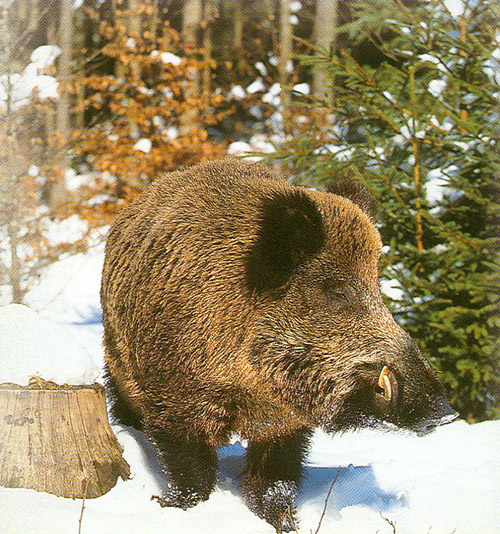Though the Park Service does try its hardest to keep animals and plants that are not native to the Smokies from harming the ecosystem for the GSMNP, over the years there have been several animals and insects that have been introduced into the environment.
 Wild Boar – In the early part of the 20th century, a group of domesticated pigs got lose from a game preserve in North Carolina. Over the next few years, the pigs made their way into the National Park and began to breed. The boars are now wild, the domesticated pigs having breed with lowland boars on their way from the lowlands in North Carolina to the mountains. The wild boar in the Smokies are now one of the most destructive mammals in the park. They root around trees destroying wildlife and even eat some of the smaller animals in the park including many of the species of amphibians that call the park home.
Wild Boar – In the early part of the 20th century, a group of domesticated pigs got lose from a game preserve in North Carolina. Over the next few years, the pigs made their way into the National Park and began to breed. The boars are now wild, the domesticated pigs having breed with lowland boars on their way from the lowlands in North Carolina to the mountains. The wild boar in the Smokies are now one of the most destructive mammals in the park. They root around trees destroying wildlife and even eat some of the smaller animals in the park including many of the species of amphibians that call the park home.
The Department of the Interior has hunts at times to help eliminate the boar from the park. Unfortunately these animals breed as fast as they are removed and the Park Service has had a hard time getting rid of this invasive species.
Hemlock Woolly Adelgid – One of the worst nonnative insect species in the Smokies is the Hemlock Woolly Adelgid. This is a sap-sucking insect that slowly kills the hemlock as they keep nutrients from getting to the leaves of the hemlock. As the leaves die, photosynthesis stops and the trees go grey and then die. The Park Rangers are experimenting with insecticides and other predatory insects to help get rid of this tree killing bug.
 Rainbow Trout – Brought in as a game fish for the tourist to the area, the aggressive rainbow trout took over the areas of the park that the brook trout (the only native trout) had formerly lived in. And while the rainbow trout is the trout that people think of when they come to the Smokies, they are a nonnative species that has hurt the ecosystem of the brook trout. There is not a plan to remove the rainbow trout but there are plans to not only bolster the brook trout but to remove some of the rainbow trout from some of the streams in the national park.
Rainbow Trout – Brought in as a game fish for the tourist to the area, the aggressive rainbow trout took over the areas of the park that the brook trout (the only native trout) had formerly lived in. And while the rainbow trout is the trout that people think of when they come to the Smokies, they are a nonnative species that has hurt the ecosystem of the brook trout. There is not a plan to remove the rainbow trout but there are plans to not only bolster the brook trout but to remove some of the rainbow trout from some of the streams in the national park.
